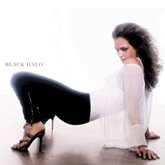Black Halo Is All Silver Lining
Designer Laurel Berman’s new office is in a state of disarray. There’s dust everywhere, and the bathroom attached to it boasts beautiful wall tiles and very little else. Berman, however, sees what will be there as soon as construction is completed. Japanese porcelain fixtures, mirrors and a serene, dust-free office are just a few short weeks away. “It’s going to be just perfect,” Berman said. Maybe it is this unflappable sense of optimism that has propelled Berman’s 9-year-old contemporary label, Black Halo, to the enviable position in which it finds itself.
Despite the economy, Black Halo has enjoyed 30 percent growth year-over-year, and in November the company moved its headquarters to a 15,000-square-foot warehouse in Los Angeles’ Arts District, more than doubling its square footage. In February, Black Halo relaunched its Web site, which includes an iPhone-enabled online store. The brand also recently debuted its first showroom in England, where it currently sells at Harvey Nichols.
To reflect its success, Berman is giving the brand a subtle makeover. A new logo, reworked hangtags that include a wearable black metal ring and a more polished Web presence all complement Black Halo’s feminine offerings, which also continue to evolve.
“I started in 2001 as a jersey line, selling my dresses in the parking lots of boutiques,” Berman said. Jersey was an inexpensive and forgiving entreacute;e into the contemporary market, Berman said. “It’s forgiving, and at the time I didn’t have the ability to hire the best sewers and pattern-makers. Cut-and-sew is hard to do,” she said. “It was a great place to start, but jersey isn’t something I could have worked with exclusively. I had to branch out, move on.”
Now Black Halo is known for its sophisticated dresses, high-waist pencil skirts, sexy blouses and the “Jackie O.”—a saucy little dress that sells like gangbusters and has been produced in 50 colors and 17 fabrications for a grand total of 20,000 dresses and counting. “I still do some jersey, but now I do it so differently,” she said, pulling a silky Grecian-inspired blouse from a rack. A new collection of gauzy thermals is Berman’s latest addition to Black Halo.
From her new headquarters, which also houses Black Halo’s distribution center, design studio, and pattern- and sample-making operations, Berman looks for ways to continue her brand’s success.
With wholesale prices ranging from $89 to $199, Black Halo isn’t competing to be the lowest-price line. Instead, Berman aims for monthly deliveries of well-made goods that sell. “You get what you pay for,” Berman said, pointing at handmade metal trim pieces destined for the Fall 2010 line. “This isn’t cheap junior trim. It is custom-made for our garments, and it is expensive. Our prices, our fit and our quality reflect that.”
Berman is proud to focus on her merchandise’s quality. “We’re made in L.A.,” she said. Local contractors give her more control over quality, which is essential when selling to specialty boutiques and better department stores. “You have to get it right, every time. There can be no issues with fit or consistency. The retailers have to trust us, and we have to earn that trust with every delivery,” Berman said.
Berman sells her line in more than 450 doors worldwide and produces 12 collections per year. Some pieces, such as the Jackie O., are no-brainers, selling season after season. Others require a careful assessment of the market. The new knits, delivering 5/30, are a response to a market that’s going a little bit more casual, Berman said. “They’re something different for us.”
“Retailers need newness, even in times like these,” the designer said. “Their customers want to come in every few weeks and see something new,” she said. “I work very closely with my retailers to understand what they need and what is selling.”
Each season, fabric sourced from Europe, India, Japan and China sparks Berman’s design process. “It all starts with the fabric,” she said. For Fall 2010, stretchy black faux leather is fated to be skinny pants with motorcycle styling and “tons of zippers.” Black Halo’s in-house pattern-makers make sure each design fits properly at every stage of its development and production. “We spend a lot of time fitting our garments and have very experienced pattern-makers. All our garments are hand-draped and are digitized for production,” Berman said.
For all of Black Halo’s momentum, Berman isn’t interested in growth for the sake of growth. “Big picture, I want to do shoes and handbags or a fragrance. None of those are in the pipeline right now, but it also isn’t a pipe dream. It can happen. Next year I might be ready for a licensing deal,” she said.
Marty Bebout, co-owner of Blue Bee, the Santa Barbara, Calif.–based specialty boutique, said he has been selling Black Halo for upwards of five years. “It always sells through. We do very well with it,” he said. Perennial favorites for his customers include the Jackie O. and feminine skirts and blouses. “Black Halo has a very classic, sexy, sophisticated look that is perfect for Blue Bee and Santa Barbara. The price is just right,” Bebout said, but another thing makes the brand a success in his store—its relative exclusivity. “I can’t sell brands that are over-distributed and can be found all over department stores. Women [recognize] Black Halo, but it isn’t over-distributed.”
























